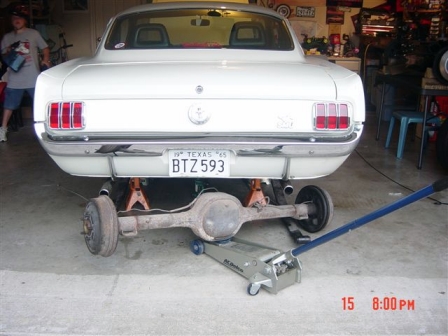
|
Installation begins with the
removal of the old 8".
Anyone looking for a complete 8" rear, 59 1/4" lug to lug
(67-68 width), new brake job, 2.80 gears... ?
I can make you a deal. |
| The
complete rear unit was removed with e-brake cables attached. At this
point, the car is being supported on the forward section of the aft frame
rails. On the right, I tried to see how I could use this setup in the snow, but
decided I couldn't get enough traction from the front wheels. |
|
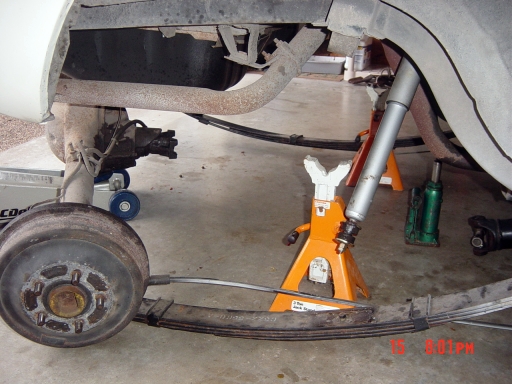
|
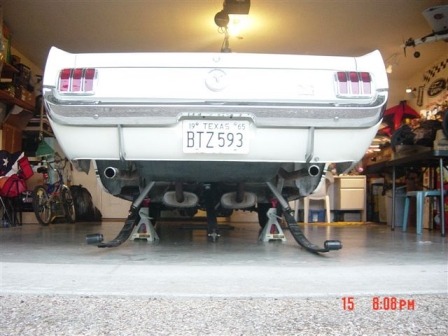 |
 | Assembly is lifted into place and springs
reattached to rear shackles. |
 | Shock mounts are positioned over axle and bolted
to springs and shocks. |
At this point, the vehicle can be returned to
support under the axle and removed from the frame rails. This will
give you weight on wheels type suspension position and help with spacing
of lines.
 | Connect emergency brake cables. |
 | Rear brake hose is attached to main hard line
from Master Cylinder Check to be sure there is adequate
clearance during suspension travel. |
|
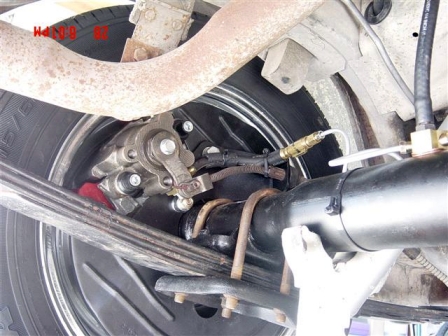 |
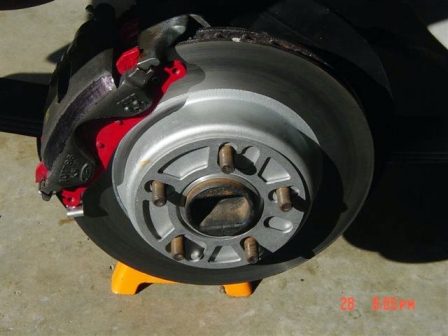 |
 | Check to make sure Ebrake cable and caliper flex
hoses clear suspension travel to upper snubber |
 | Axle breather tube is connected to vent and run
through wheelwell. |
 | Driveshaft reconnected at the U-Joint. |
 | Secure hard brake lines to axle with insulators
and zip ties (and anywhere else a flex line could rub and chafe) |
 | Secure caliper flex line to e-brake cable. |
Left: 15" Magnum 500s did not clear the
calipers. The weld bead of the wheel was too rough. Rather
than grind on wheels, I installed 1/8" spacers. This provided
the necessary clearance and did not impact overall width.
|
| Maverick
master cylinder was removed, and replaced with a Classic
Performance Products custom street rod M/C designed for 4 wheel
discs. Unit has two equal size bowls, standard 3/16" ports on
both sides, and can be used with either manual or power brakes. CPP
Part number is M-C118-S. M/C has
a 1 1/8" piston. The height is at least 3/8" shorter than
a standard Ford M/C, and I needed one compact enough to clear my clutch
cable. New units were clearance items for about $25 on Ebay.
Unit must be bench
bled prior to installation.
In lower right, you can see the small Tee used to
attach the rear bowl to the front two wheels. The front bowl is
routed through an SSBC adjustable proportioning
valve, then to the main
line to the rear wheels.
|
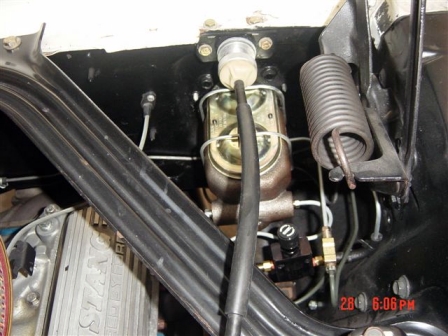
|
|
|
From Glen Buzek:
| I used a master cylinder
from O'Riley's. Master cylinder Part # 10-1614 or Cardone #
10-1614. For a 78 (I think) Granada,
V8 with 4 wheel disk brakes.
Also needed Brake Line
Adapter Fittings to mate with brake lines # 258403 & #258302.
One each.
|
|
|
|
|
| LINKS |
| UltraStang
Lincoln Mark VII Rear Brake Order Page
UltraStang
Rear Brake Install Instructions
Glen Buzek's Page
on Installing Mark VII brakes with 14" Wheels
Classic Performance Products
Home page
Making your
own Brake and Fuel Lines |
|
Go back to Page 1
Home |
________________________________________________
Additional Notes:
From Steve Ainsworth:
This has been a tough problem in figuring out what
"modern" MC will work for this application. By modern, I mean a MC
that has a cylindrical aluminum body with a plastic reservoir. I
prefer this setup over a conventional cast-iron MC (or even a conventionally
designed aluminum MC) for several reasons.
- Very light weight.
- The aluminum doesn't rust and look ugly like a cast-iron MC
does.
- And most advantageous of all, you don't have to open up the
lid to check the fluid level. Opening the lid opens up the door to introduce
dirt and contaminants into the reservoir, which ultimately ends up in the
braking system. It also allows air and moisture to get in, which has ill-effects
on braking performance.
I first tried using a MC from a '94-'98 SN-95 Mustang GT, but
the way the plastic reservoir is made, the rear is higher than the front when
mounted in a vintage Mustang when mounted on a Fox brake booster. In the '94-'98
GTs, the MC runs at a slight up-hill slope, so the reservoir sits level in that
application. But, when you mount the '94-'98 GT MC on a Fox brake booster in a
vintage Mustang, the MC sits pretty much level. This makes the reservoir slope
downward at the front. This would starve the rear port of the MC for fluid, so
that wouldn't work.
I next tried using a MC for a 2001 Ford F-150 w/4-wheel disc
brakes. Unlike the SN-95 GT MC, the '01 F-150 MC's ports exit on the driver's
side. It's reservoir also has more fluid volume capacity compared to the SN-95
GT MC, as well as a larger piston bore diameter. This would have been a
excellent choice except for one thing --It's too long to use with the 5.0L
version of the Fox brake booster! (about 8-1/8" long)....However...it would
work with the 2.3L brake booster...hmmmm........
Finally after more searching, I checked out a '94-'98 SN-95
Mustang V-6 MC. After looking at the front calipers on a '96 V-6 Mustang at a
wrecking yard, I saw that the caliper's piston diameter was about the same as
that of a '75-'80 Granada's caliper, so it should be well capable of actuating
the pistons for those that have done the Granada swap.
SN-95 V-6 MC specs:
- 7-3/8" long (mounting flange to tip).
- 1-1/8" piston bore.
- Compact, Cylindrical aluminum body w/plastic reservoir.
- Works with BOTH 2.3L & 5.0L Fox brake boosters in '64½-'70
Mustangs.
- Right-hand ports (even so, no clearance problems between
hard lines and small-block engine when everything is installed. --do not know
about on big-block applications, though).
Pricing may scare some, though. The '94-'98 Mustang V-6 MC
assembly, new, from Ford (p/n F6ZZ-2140-A) is $146.88. Another, cheaper
alternative to this MC is to purchase a rebuilt unit from O'Reilly's (under
Cardone p/n 10-2908). Price is $54.99 + $21.00 core charge. However, note that
the Cardone unit DOES NOT come with a reservoir, and you CANNOT get a reservoir
through Ford (been there, done that). If you went this route, you would have to
get a reservoir from a '94-'98 Mustang V-6 salvage yard donor.
If you robbed the reservoir from a salvage yard donor, get the
MC's brake line fittings too. Otherwise, you will need two bubble
flare-to-inverted flare adapters (Edelmann p/n 265000 & 271300 --about $6.50
for the pair).
--Steve





